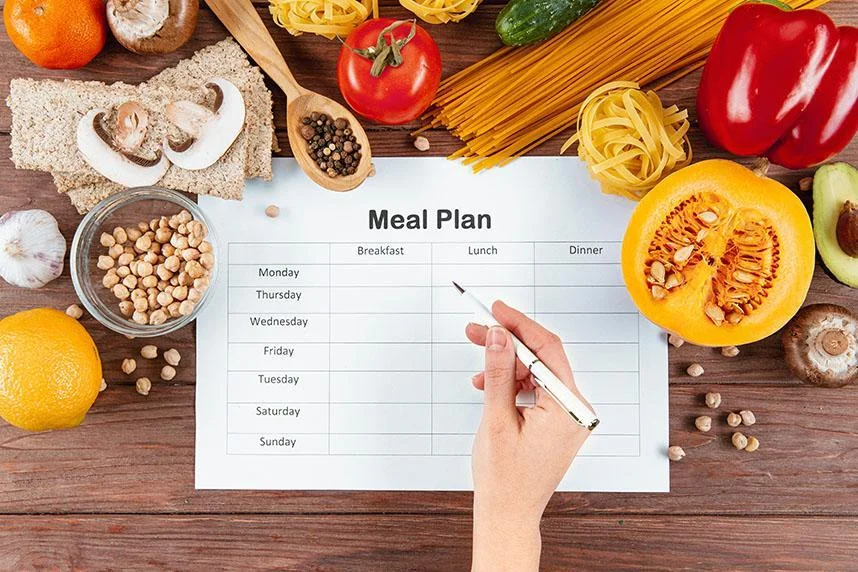Healthy Eating Meal Plans For Weight Loss And Wellness: Embarking on a journey toward weight loss and enhanced wellness requires a strategic approach to nutrition. A well-designed meal plan, rich in whole foods and tailored to individual needs, can be a powerful tool for achieving these goals. This article explores the essential components of healthy eating meal plans, provides sample meal ideas, and offers practical tips for creating a sustainable and effective dietary strategy.
The Importance of Meal Planning for Weight Loss and Wellness
Meal planning is vital for weight loss and overall wellness for several reasons. It helps manage calorie intake, ensures a balanced nutrient profile, and promotes mindful eating habits.
Key Components of a Healthy Eating Meal Plan

- Whole Foods Focus: A healthy eating meal plan should prioritize whole, unprocessed foods. This includes fruits, vegetables, whole grains, lean proteins, and healthy fats.
- Balanced Macronutrients: A balanced intake of macronutrients—carbohydrates, proteins, and fats—is crucial. The Mayo Clinic Diet emphasizes eating most foods from the base of their Healthy Weight Pyramid, encouraging unlimited amounts of vegetables and fruits.
- Calorie Control: To lose weight, it’s generally necessary to reduce calorie intake. A reduction of 500 to 750 calories per day can lead to a weight loss of 1–1 ½ pounds per week. Very low-calorie diets should only be followed under medical supervision.
- Portion Control: Being aware of portion sizes and the ratios of different macronutrients is essential for managing weight. The Mayo Clinic Diet teaches how to estimate portion sizes, making healthy eating easier.
- Regular Meal Timing: Eating at consistent times can help regulate hunger and prevent overeating. Avoiding long periods without food can reduce cravings for unhealthy snacks.
Sample Meal Plan Ideas
Low Carb Meal Plan:
- Day 1:
- Breakfast: 2 slices sprouted Ezekiel bread with 1/2 avocado, salt, and pepper.
- Lunch: 3 oz grilled chicken with 2 cups zucchini noodles made with 1 clove of garlic, butter, and 1 oz Parmesan.
- Dinner: Bunless burger with a slice of Cheddar cheese, served with 1/2 cup cooked broccoli and 2 tablespoons of salsa.
- Day 2:
- Breakfast: 7 oz plain Greek yogurt with 1/4 cup blueberries and 1 oz almonds.
- Lunch: 3 oz rib eye roast with 1/2 cup mashed rutabaga and 1 cup sautéed green beans.
- Dinner: 3 oz baked salmon with 1/2 cup cooked asparagus and 3/4 cup cauliflower rice.
Heart-Healthy Meal Plan:
- Breakfast: Mixed fruit parfait (cantaloupe, strawberries, blueberries, kiwi) with a side of whole-grain toast.
- Lunch: 1 cup whole grain pasta with mixed vegetables (tomato, onion, kale) cooked in a skillet with 1 tbsp lemon and olive oil.
- Dinner: 2 oz serving of salmon, with a side of green beans.
- Snack: 1 cup of mixed nuts — almonds, walnuts, and cashews.
Sample Meal Plan for Men (19-50 years):
- Breakfast: 2 slices of wholegrain toast with 2 teaspoon margarine, ½ cup canned baked beans, 1 medium tomato and a glass of reduced fat milk.
- Morning break: 1 medium apple and small coffee with milk.
- Lunch: Wholegrain sandwich with roast beef, reduced fat cheese and mixed salad with polyunsaturated margarine.
- Afternoon break: 30g of unsalted nuts and small coffee with milk.
- Dinner: Fish prepared with olive oil, boiled rice, potato, carrots and broccoli.
- Evening snack: Fruit salad and reduced fat yoghurt.
Tips for Creating a Sustainable Meal Plan

- Set Realistic Goals: Start by setting achievable goals for weight loss and wellness. Consider how much weight you need to lose, your activity levels, and any dietary requirements for health conditions.
- Tailor to Individual Needs: A meal plan should align with personal, cultural, or religious dietary requirements. Consider how much time you have for food preparation and shopping, your level of cooking expertise, and whether the meal plan needs to include other members of the household.
- Plan and Prepare: Plan your meals in advance and prepare ingredients to save time during the week. Batch-cooking healthy meals for the freezer can be a time-saving strategy.
- Hydrate Adequately: Maintain hydration to reduce cravings for sugary drinks. Water is essential for overall health and can help control appetite.
- Seek Professional Guidance: Consult with a registered dietitian or healthcare provider for personalized advice.
Also Read : What Are The Vegan Diet Advantages For Health?
Conclusion
Creating a healthy eating meal plan is a crucial step toward achieving weight loss and wellness goals. By focusing on whole foods, balancing macronutrients, controlling calories and portions, and planning meals, individuals can create a sustainable and effective dietary strategy. A personalized approach, tailored to individual needs and preferences, is essential for long-term success.
FAQs
What is the first step in creating a healthy eating meal plan?
The first step is to assess your individual needs and set realistic goals.
How important is portion control in a weight loss meal plan?
Portion control is essential for managing calorie intake and achieving weight loss.
What types of foods should be prioritized in a healthy eating meal plan?
Whole, unprocessed foods such as fruits, vegetables, whole grains, and lean proteins should be prioritized.
How can Healthy Eating Meal Plans help with weight loss?
Meal planning helps manage calorie intake, ensures a balanced nutrient profile, and promotes mindful eating habits.
Is it necessary to count calories when following a healthy eating meal plan?
The Mayo Clinic Diet emphasizes that the best way to keep weight off for good is to change your lifestyle and adopt new habits that you enjoy and can stick with and it doesn’t require you to be precise about counting calories.





